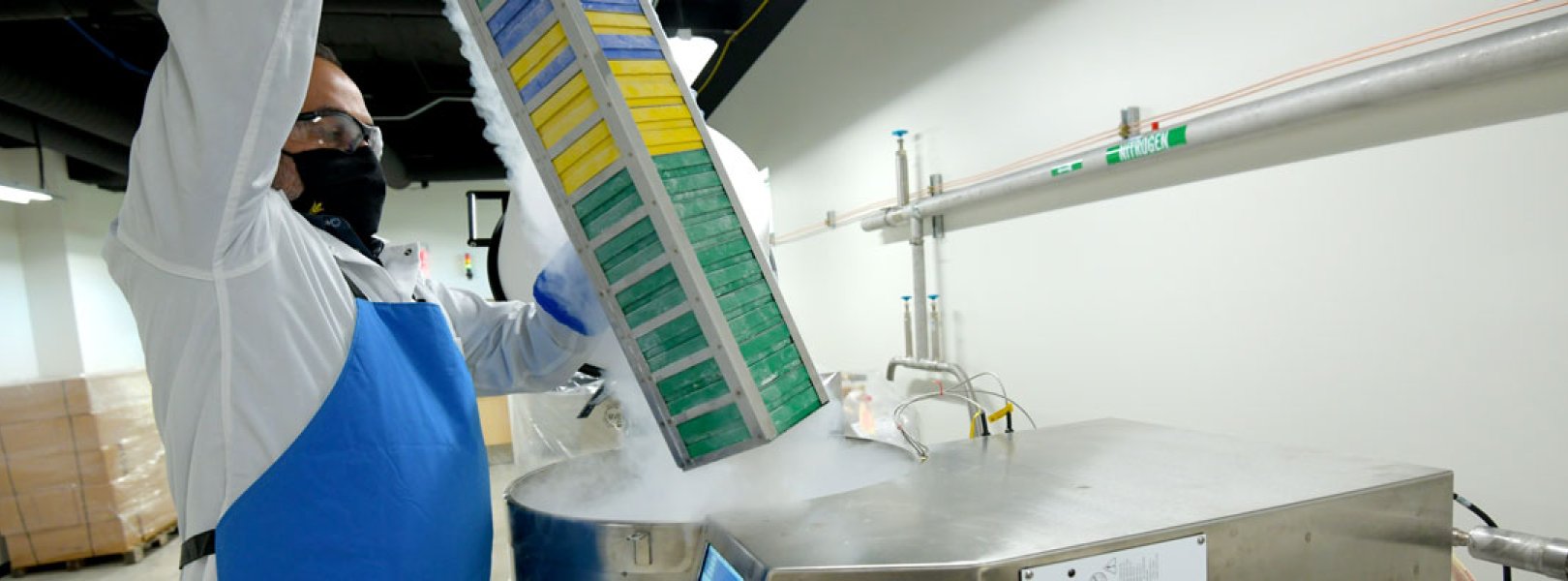Discover and Use NEON Samples

The primary NEON Biorepository is curated by Arizona State University and encompasses the long-term storage and curation of most NEON samples and specimens which include voucher specimens, whole organisms, tissues, and samples that are collected and processed for chemistry, disease and genetics. Explore our general catalog of samples to learn more about the types of samples that we collect and archive.
Discover NEON Samples
- Samples and data are collected together. NEON data products that include sampling have sample Identifiers in their data tables. Within each data product download, an accompanying table that describes the products' variables will help you identify the sample identifier variable names and the data table(s) in which they appear.
- Sample identifiers can be entered into the NEON Sample Viewer to look up the current location of a particular sample.
- The Symbiota-based NEON Biorepository data portal provides an online, searchable database.
- For more general inquiries, please contact the NEON Biorepository team at ASU.
| Physical samples | Data Product Name/ID |
|---|---|
| All | Aquatic plant bryophyte macroalgae clip harvest (DP1.20066.001) |
| Partial | Aquatic plant, bryophyte, lichen, and macroalgae point counts in wadeable streams NEON.DP1.20072 |
| All | Benthic microbe community composition (DP1.20086.001) |
| All | Benthic microbe group abundances (DP1.20277.001) |
| All | Benthic microbe marker gene sequences (DP1.20280.001) |
| All | Benthic microbe metagenome sequences (DP1.20279.001) |
| None | Breeding landbird point counts (DP1.10003.001) |
| Partial | Fish electrofishing, gill netting, and fyke netting counts (DP1.20107.001) |
| All | Ground beetles sampled from pitfall traps (DP1.10022.001) |
| All | Macroinvertebrate collection (DP1.20120.001) |
| All | Mosquito-borne pathogen status (DP1.10041.001) |
| Partial | Mosquitoes sampled from CO2 traps (DP1.10043.001) |
| All | Periphyton, seston, and phytoplankton collection (DP1.20166.001) |
| None | Plant phenology observations (DP1.10055.001) |
| Vouchers only | Plant presence and percent cover (DP1.10058.001) |
| All | Rodent-borne pathogen status (DP1.10064.001) |
| Partial | Small mammal box trapping (DP1.10072.001) |
| All | Soil microbe community composition(DP1.10081.001) |
| All | Soil microbe marker gene sequences (DP1.10108.001) |
| All | Soil microbe metagenome sequences (DP1.10107.001) |
| All | Surface water microbe community composition (DP1.20141.001) |
| All | Surface water microbe group abundances (DP1.20278.001) |
| All | Surface water microbe marker gene sequences (DP1.20282.001) |
| All | Surface water microbe metagenome sequences DP1.20281.001) |
| All | Tick-borne pathogen status (DP1.10092.001) |
| All | Ticks sampled using drag cloths (DP1.10093.001) |
| Tissue samples only | Woody plant vegetation structure (DP1.10098.001) |
| All | Zooplankton collection (DP1.20219.001) |
| All | Zooplankton DNA barcode (DP1.20221.001) |
| All | Macroinvertebrate DNA barcode (DP1.20126.001) |
Types of Sample Requests
- Loans for non-destructive use: These loans are typically granted for a 6-12 month period; a longer period of time may be accommodated if properly justified. Ordinarily, no more than one-half of a sample or series of samples from a NEON site may be borrowed at any one time for non-destructive use. All loan requests, no matter the quantity, are considered on a case-by-case basis. Endangered taxa, fragile specimens, or samples which are deemed to be in limited supply are generally not considered for loans. Because the NEON Biorepository is a community resource with finite materials, we ask that requestors only ask for what they need and do not request excess samples.
- Loans for destructive or consumptive use: Decisions to grant or not grant permission for destructive/consumptive/invasive sampling will be based on: (1) rarity of the species or sample and its representation within the NEON Biorepository collections; (2) degree of destruction/consumption/invasiveness; (3) physical condition of the specimen(s); (4) significance of the proposed research relative to NEON’s mission to enable continental-scale ecology; and (5) qualifications of the investigators. Any physical material remaining after the analysis will be returned to the NEON Biorepository unless otherwise agreed upon in writing. Because the NEON Biorepository is a community resource with finite materials, we ask that requestors only ask for what they need and do not request excess samples.
Considerations for Approval
The internal evaluation and approval of sample requests will focus on technical and logistical criteria as well as scientific justification, particularly for requests for destructive or consumptive use. The latter is not intended to subsume the scientific merit review that may have been conducted by the sponsoring agency; but rather is a means to ensure the highest and best use of this valuable but limited resource, as well as transparency and accountability to the greater research and collections communities.

A technician handles samples at the NEON Biorepository at Arizona State University.
Accessing Samples via the Biorepository
Cost of shipping will be handled on a case-by-case basis. At present, the NEON Biorepository foresees retaining the ability to cover shipping costs for small-scale or exploratory studies when no other funding is available. Larger-scale and/or long-term sample shipping needs will typically have to be financed by the corresponding external research team.
For large or complicated requests of material, researchers will be encouraged to visit the NEON Biorepository, using their own funds, to select specimens for sampling or to study them directly on site when suitable. Removal of material from samples selected by the researcher must be approved by appropriate NEON Biorepository staff. Not only does a personal visit reduce the work required of staff, it allows the investigator to make more precise selections of material to be used, or even accomplish an entire research task on site.
Samples Hosted at Other Institutions
Some NEON samples have already been archived at other facilities. Requests for these samples should be made directly to the hosting organization. See our Sample Repositories page to learn more.